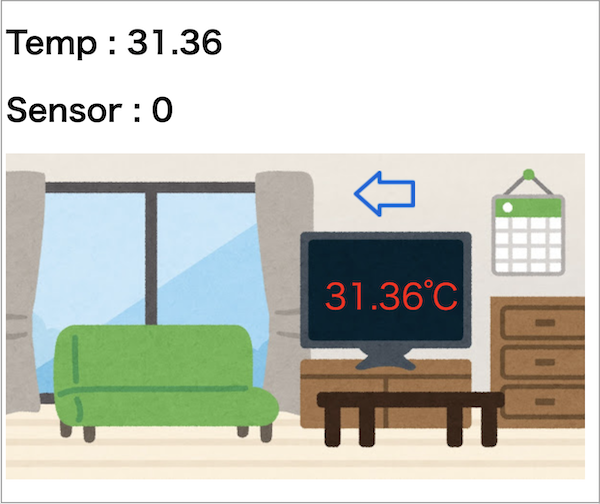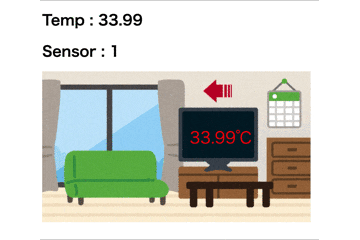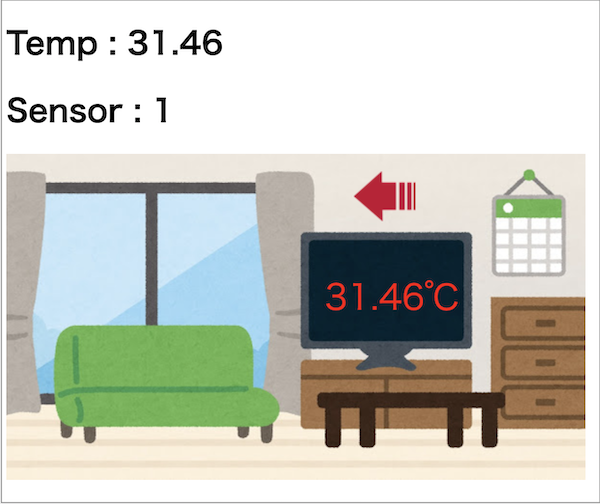はじめに
Raspberry Piで温度計測とGPIOでセンサー状態を取得するとき、ソフトウェア単体でデバッグできると便利です。
そこで温度計測とGPIOでセンサー状態の取得をシミュレートし、Webサイト(Flaskで作成)へ表示するデバッグ環境を作成しました。
シミュレートした温度とセンサー状態はSQLiteに保存し、Ajax経由でページを更新します。
温度とセンサー状態の数値では分かりにくいので、あたかもリビングの温度とセンサーが変化したように見せています。
この環境ではブレッドボードや配線は不要です。
リアルタイム性を必要とする温度計測やセンサー状態の取得には向いていません。30秒間隔で温度が分かれば良いという程度の環境を想定しています。
動作イメージ
- 温度とセンサー状態の矢印が更新されます。
環境
- Raspberry Pi3 B
- Python 3.7.2
- Flask
- SQLite3
- Sqlalchemy
- jQuery 3.4.1
インストール
Python環境
- ここではSensorフォルダを作成し、pipenvで環境をインストールします。
- pipenv、Webサーバ(Nginx, uWSGIなど)のインストールは割愛します。
$ mkdir Sensor
$ cd Sensor
$ pipenv install --python 3.7.2
$ pipenv install flask
$ pipenv install sqlalchemy
$ pipenv shell
フォルダとファイル構成
- 下記のフォルダとファイルを作成します。
- jQueryは、jQueryから適したバージョンをダウンロードします。
- 矢印アイコン(On/Off)は、【フリーアイコン】 矢印(上下左右)などからダウンロードします。
- 背景は、かわいいフリー素材集 いらすとやなどからダウンロードします。
└ Sensor/
├ server.py
├ app/
│ ├ app.py
│ └ static/
│ │ ├ css/
│ │ │ └ sample.css
│ │ ├ img/
│ │ │ ├ arrow_on.png # Onのときの矢印
│ │ │ ├ arrow_off.png # Offのときの矢印
│ │ │ └ bg_house_living.jpg # 背景画像
│ │ ├ jquery/
│ │ │ └ jquery-3.4.1-min.js
│ │ └ js/
│ │ └ sample.js
│ └ templates/
│ └ index.html
├ models/ # SQLite3定義
│ ├ __init__.py
│ ├ database.py
│ └ models.py
└ output_log/ # バックグラウンド実行のログフォルダ
ソースコード
サーバメイン処理
- init_db()でDatabaseを初期化します。(*.dbファイルが存在しない場合のみ実行されます)
# -*- coding: utf-8 -*-
from flask import Flask
from app.app import app
from models.database import init_db
if __name__ == "__main__":
# Database初期化
init_db()
# アプリ起動(host=0,0,0,0で全てのアクセス許可)
app.run(host='0.0.0.0', debug=True)
温度とセンサーのシミュレート処理
- 3秒間隔で温度とセンサーをシミュレートします。
- 温度は25度+αでシミュレートします。
- センサーは0 or 1でシミュレートします。
(参考)
Pythonで定周期で実行する方法と検証
# -*- coding: utf-8 -*-
import time
import threading
import random
from models.models import SensorCurrent
from models.database import db_session
from datetime import datetime
# 定期実行処理
def schedule():
# 温度シミュレート(25度+α)
now = time.time()
temp = 25 + now % 5 + (now / 10) % 10
# 小数点第2位に切り捨て
str = "{0:.2f}".format(temp)
temp = float(str)
# センサー状態シミュレート(0 or 1)
sensor = random.randint(0, 1)
# 現在データ更新
current = SensorCurrent.query.first()
current.temp1 = temp
current.sensor1 = sensor
db_session.commit()
db_session.close()
# 定期実行設定処理
def scheduler(interval, f, wait = True):
base_time = time.time()
next_time = 0
while True:
t = threading.Thread(target = f)
t.start()
if wait:
t.join()
next_time = ((base_time - time.time()) % interval) or interval
time.sleep(next_time)
if __name__ == "__main__":
# 定期実行設定(3秒間隔)
scheduler(3, schedule, True)
アプリメイン処理
- Webサイト表示とAjax処理を記述します。
# -*- coding: utf-8 -*-
from flask import Flask,render_template,request, json, jsonify
from models.models import SensorCurrent
app = Flask(__name__)
# Webサイト表示処理
@app.route("/")
def index():
# SQliteから温度とセンサーの現在データを取得
data = SensorCurrent.query.first()
return render_template("index.html",sensor=data)
# Ajax処理
@app.route("/currdata", methods=['POST'])
def getCurrData():
# SQliteから温度とセンサーの現在データを取得
data = SensorCurrent.query.first()
# JSONに変換して結果を返す
json_data = {
'sensor1': data.sensor1,
'temp1': data.temp1
}
return jsonify(Result=json.dumps(json_data))
if __name__ == "__main__":
app.run(debug=True)
データベース定義
- SQLite3データベース(sensor.db)を定義します。
# -*- coding: utf-8 -*-
from sqlalchemy import create_engine
from sqlalchemy.orm import scoped_session, sessionmaker
from sqlalchemy.ext.declarative import declarative_base
import os
# データベースファイル設定
databese_file = os.path.join(os.path.abspath(os.path.dirname(__file__)), 'sensor.db')
engine = create_engine('sqlite:///' + databese_file, convert_unicode=True)
db_session = scoped_session(sessionmaker(autocommit=False,autoflush=False,bind=engine))
Base = declarative_base()
Base.query = db_session.query_property()
# データベース初期化
def init_db():
import models.models
Base.metadata.create_all(bind=engine)
テーブル定義
- 温度とセンサーの現在データテーブル(currdata)を定義します。
# -*- coding: utf-8 -*-
from sqlalchemy import Column, Integer, Float, String, Text, DateTime
from models.database import Base
from datetime import datetime
# 温度とセンサーの現在データテーブル定義
# ここでは温度データ1つ, センサーデータ1つを保存
# テーブル定義は適宜設定してください
class SensorCurrent(Base):
__tablename__ = 'currdata'
id = Column(Integer, primary_key=True)
name = Column(String(128))
temp1 = Column(Float)
sensor1 = Column(Integer)
date = Column(DateTime, default=datetime.now())
def __init__(self, name=None, temp1=None, sensor1=None, date=None):
self.name = name
self.temp1 = temp1
self.sensor1 = sensor1
self.date = date
def __repr__(self):
return '<Name %r>' % (self.name)
Flaskを使用したメインページ
- 起動時に現在データを取得して表示します。(矢印のデフォルトはOffです)
- Ajaxを利用して2秒間隔で現在データを取得してページを書き換えます。
<!DOCTYPE html>
<html lang="ja">
<head>
<meta charset="utf-8">
<title>{{sensor.name}}</title>
<meta name="viewport" content="width=device-width,initial-scale=1.0">
<link rel="stylesheet" type="text/css" href="../static/css/sample.css">
<script src="../static/jquery/jquery-3.4.1.min.js"></script>
<script src="../static/js/sample.js"></script>
</head>
<body>
<h1 id="h1_temp1">Temp : {{sensor.temp1}}</h1>
<h1 id="h1_sensor1">Sensor : {{sensor.sensor1}}</h1>
<div class="sample-box">
<img class="sample-box-bg" src="../static/img/bg_house_living.jpg" alt="">
<div class="sample-sensor">
<img class="sample-sensor-img" id="sensor1" src="../static/img/arrow_off.png" alt="">
</div>
<div id="temp1" class="sample-tempareture">
</div>
</div>
</body>
<script>
setInterval(function () {
getcurrdata();
}, 2000);
</script>
</html>
現在データ取得処理
- Ajaxを利用して現在データを取得します。
// 現在データ取得
function getcurrdata() {
$.ajax({
type: 'POST',
url: '/currdata',
data: '',
contentType: 'application/json'
})
.done( (data) => {
// データ取得成功
console.log("success");
// JSONからデータ抽出
var json_data = JSON.parse(data.Result);
const sensor1 = json_data.sensor1;
const temp1 = json_data.temp1;
// 背景画像内に温度設定
$("#temp1").html(temp1 + "℃");
// 温度設定(確認用)
$("#h1_temp1").html("Temp : " + temp1);
// センサー画像設定
if (sensor1 == 0) {
$("#sensor1").attr("src", "../static/img/arrow_off.png");
} else {
$("#sensor1").attr("src", "../static/img/arrow_on.png");
}
// センサー設定(確認用)
$("#h1_sensor1").html("Sensor : " + sensor1);
})
.fail( (data) => {
// データ取得失敗
console.log("error");
});
}
メインページのCSS
- 簡易的にレスポンシブデザインに対応しています。
@charset "utf-8";
@media screen and (min-width: 481px) {
.sample-box {
position: relative;
display:inline-block;
}
.sample-box-bg {
}
.sample-sensor {
position: absolute;
left: 60%;
top: 5%;
}
.sample-sensor-img {
}
.sample-tempareture {
position: absolute;
top: 35%;
left: 55%;
color: RED;
font-size: 36px;
}
}
@media screen and (max-width: 480px) {
.sample-box {
position: relative;
display:inline-block;
}
.sample-box-bg {
width: 100%;
}
.sample-sensor {
position: absolute;
left: 60%;
top: 5%;
}
.sample-sensor-img {
width: 70%;
height: 70%;
}
.sample-tempareture {
position: absolute;
top: 35%;
left: 55%;
color: RED;
font-size: 22px;
}
}
操作方法
温度とセンサーのシミュレートからWebサイトの表示までを説明します。
温度とセンサーの初期値を設定
- 温度とセンサーの初期値(1件のみ)currdataテーブルへ追加します。
- Sensorフォルダでpythonを起動し、下記のソースコードを実行します。
- 1回のみ実行でOKです。
$ python
from models.database import db_session
from models.models import SensorCurrent
data = SensorCurrent("サンプル",25.3, 0)
db_session.add(data)
db_session.commit()
exit()
温度とセンサーのシミュレート開始
- Sensorフォルダから、バックグラウンドで温度とセンサーをシミュレートするアプリを起動します。
- バックグラウンドで実行するのは、サーバアプリと同時に実行したいためです。
# 下記のフォルダで実行
(Sensor) pi@raspberrypi:~/Sensor $
# 以下のコマンドを実行
nohup python sensor.py > ./output_log/out.log &
- 既にシミュレートを開始している場合は、プロセスをkillしてから開始します。
# pythonを実行しているプロセスを検索
$ ps aux | grep python
pi 22965 0.7 2.0 32200 19176 pts/2 S 16:43 0:27 python sensor.py
# sensor.pyプロセスをkill
$ kill -9 (sensor.pyのプロセスID -> ここでは22965)
Webサーバを起動
- サーバメイン処理を起動します。
# 下記のフォルダで実行
(Sensor) pi@raspberrypi:~/Sensor $
# 以下のコマンドを実行
python server.py
表示確認
- ブラウザを起動し、http://127.0.0.1:5000へアクセスします。
- WebサーバのローカルIPアドレスへのアクセスでもOKです。
- スマートフォンからアクセスした場合、簡易的にレスポンシブデザインが適用されていると思います。
おわりに
Raspberry PiでIoTを試したいけど、ハードウェアも同時開発だったり、ブレッドボードや配線が用意できないとき、簡易的にシミュレートできます。温度やセンサー数はSQLiteの定義により自由に設計できるので、これから活用していこうと思います。
参考
下記のサイトを参考にさせていただきました。
Webアプリ開発未経験者がFlaskとSQLiteとHerokuを使って1週間でサービス公開までする
Raspberry pi + Nginx + uWSGIでWebサーバーを立ち上げDjangoアプリをデプロイしてみる その1
Pythonで定周期で実行する方法と検証
バックグラウンド実行で時間短縮しよう!!


